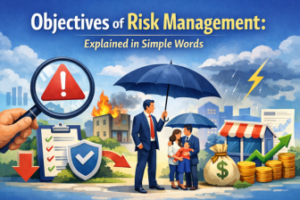
What are Risk Management Strategies? Top Strategies to Follow
What are Risk Management Strategies? Top Strategies to Follow
Uncertainty is unavoidable in today’s business environment, which has become highly complex. Moreover, unpredictability in the market, cybercrimes, operational interruptions, or changes in regulations are some of the risks every organization must be prepared to embrace. These risks, though unknown in nature, can hinder growth, damage reputation, or even threaten survival.
That is where risk management strategies come into play. Risk management is not only about identifying threats, but also about developing systematic methods to reduce their impact so that challenges can transform into opportunities.
This article offers an insight into Risk Management Strategies, why they matter, and the key approaches organizations need to pursue to build resilience and sustain long-term success. If you are considering building expertise in this field, enrolling in a reputed risk management institute in India can offer both practical skills and industry-relevant knowledge.
What Are Risk Management Strategies?
Risk management strategies are well-organized plans and procedures that businesses adopt to address, evaluate, and eliminate potential risks. Since these strategies are specific to a business’s risk appetite, they often form a crucial part of the overall risk management plan.
The goal is to stay ahead of uncertainties and minimize the negative impact of adverse events through informed decision-making.
Simply put, risk management strategies enable businesses to avoid being caught off guard. They help leaders pre-plan, allocate resources efficiently, and maintain operational stability—even in turbulent times.
Importance of Risk Management Strategies
Business Continuity: Effective strategies ensure that an organization continues to function during a crisis and recovers afterward.
Regulatory Compliance: As regulations grow stricter—especially in sectors like finance, healthcare, and manufacturing—organizations must demonstrate that they actively mitigate risks.
Reputation Management: Strong strategies protect stakeholder trust and preserve brand reputation.
Financial Health: Risk approaches reduce the cost of lawsuits, fines, fraud, and temporary operational shutdowns.
Competitive Advantage: A robust framework helps companies adapt quickly to market changes, keeping them ahead of competitors.
Types of Risk Management Plans
1. Risk Determination and Evaluation
The first and most important step is to identify the types of risks the organization may face. These could be strategic, operational, financial, reputational, or legal. Once identified, businesses need to evaluate the likelihood and severity of these risks. Common methods include SWOT analysis, PESTLE analysis, and risk mapping.
💡 Tip: Involve cross-functional teams during this process to gain diverse perspectives on potential risks.
2. Risk Avoidance
Sometimes, the best way to manage a risk is to avoid it altogether. This involves modifying plans or avoiding activities that pose a high level of risk. For example, a company may choose not to invest in a politically unstable region, even if there is market potential.
👉 Usage: Apply this strategy when the perceived negative consequences outweigh the potential benefits.
3. Risk Mitigation or Reduction
Risk mitigation includes actions that reduce the impact or likelihood of a risk. This can involve investing in better technology, conducting regular audits, training employees, or diversifying suppliers.
Example: A financial services company may use encryption and two-factor authentication to lower the risk of cyberattacks.
4. Risk Transfer
Risk transfer shifts the financial burden of a risk to a third party, usually through insurance or outsourcing. While the risk remains, its impact on the organization decreases significantly.
Example: A company can purchase cyber liability insurance to cover the costs associated with a data breach.
5. Risk Acceptance
Not all risks can or should be avoided or transferred. In some cases, businesses may accept certain risks and monitor them closely. This is common for low-impact risks with a low probability of occurrence.
Example: Companies often develop backup plans and set up review mechanisms to manage such risks effectively.
6. Contingency Planning
Contingency planning, also known as a Plan B, ensures backup solutions exist in case the original plan fails. Examples include Business Continuity Planning (BCP) and Disaster Recovery Planning (DRP).
Example: A retail chain can prepare for supply chain disruptions by partnering with multiple logistics providers.
7. Regulatory and Legal Risk Management
It is crucial to stay updated with changing laws, tax regulations, data privacy policies (such as GDPR), and labor laws. A robust compliance strategy prevents legal issues or penalties.
💡 Tool Tip: Use compliance software to automate monitoring and generate timely reports.
8. Financial Risk Management
This strategy uses tools like hedging, portfolio diversification, and Value-at-Risk (VaR) analysis to manage financial risks. These risks often relate to interest rates, credit, foreign exchange fluctuations, and market volatility.
Example: Exporters frequently use forward contracts to lock in exchange rates and minimize currency risk.
9. Enterprise Risk Management (ERM)
ERM is a holistic approach that integrates risk management across all strategic initiatives and decision-making processes. It aligns risk appetite with organizational goals and promotes a risk-aware culture.
👉 Why It Works: ERM eliminates silos and fosters cross-departmental collaboration in addressing risks.
10. Ongoing Monitoring and Review
Risk management is not a one-time activity. Organizations must update and assess strategies continuously to respond to emerging threats. Regular reviews, risk reporting, and feedback loops help keep strategies relevant and effective.
💡 Pro Tip: Use dashboards and Key Risk Indicators (KRIs) to monitor trends in real-time.
Conclusion
Risk management strategies require a mix of analytical thinking, business insight, and a deep understanding of industry-specific challenges. Professionals—whether new graduates or experienced workers—who want to build or advance their careers in this field should consider formal training in risk management.
The Global Risk Management Institute (GRMI) is a highly regarded institution that offers specialized programs tailored to the evolving landscape of risk management. Its curriculum combines academic theory with real-life case studies, preparing candidates for the complex challenges they will face in today’s environment. GRMI’s one-year postgraduate programs and certifications emphasize practical skills that can be applied immediately in the workplace.
Whether you are a fresh graduate or a working professional seeking career growth, enrolling in a formal risk management course in India such as from an institute like GRMI is a valuable step. It equips you with the tools to design, implement, and lead effective risk strategies that contribute to long-term business success.
You may also like

Objectives of Risk Management: Explained in Simple Words

Cybersecurity Interview Questions for Beginners


